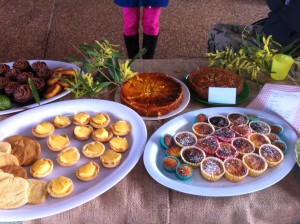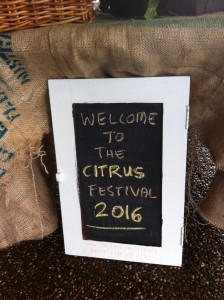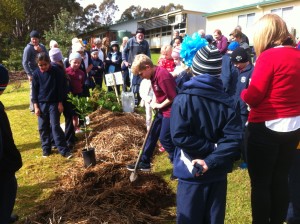WHAT’S IN SEASON – April 2016
As we move towards the end of summer, there is still the abundance of summer vegetables available, masses of different varieties of tomatoes, cucumbers, eggplants, zucchinis, as well as so many greens – lettuce, kale, silverbeet and chard. The cooler weather is bringing delights such as some delicious Berlotti beans, fennel and golden as well as red beetroot, celeriac and fennel. Many are coping with masses of basil at the end of the season and still there is an abundance of chillies and herbs. New season very early local ginger and Jerusalem artichokes are just appearing In our area, while any olives which the birds have left, are ready to pick and pickle for later. New season potatoes such as Dutch creams, Kiffler, Sebago and Maranka are now available. Look out for the first pine and other types of mushrooms as the days get cooler.
There are now many varieties of new season apples appearing, including the later Pink Lady and Granny Smith and various heritage varieties. Nashi pears, pears and quinces as well as crabapples and strawberry quavas, will keep us busy making delicious jellies and tarts. It is prime season now for juicy figs, which will finish shortly but also for rhubarb, pomegranites and custard apples, all of which have a short season. All types of melons are delicious at present. The first early season mandarins are available but thankfully limes and lemons are much cheaper than a few months ago.
Autumn is a prime time for seafood with fish such as slimy mackerel, King George whiting, tuna both yellow fin and albacore being especially abundant and delicious at present. Even sea mullet is good and can be cooked and smoked to give a delicious reasonable meal, high in omega 3 oils Southern calamari and oysters from Merimbula are available as well as a variety of crabs from South Australia.
Pork, ham and bacon are the best buys at present of all the red meats, with both lamb and beef remaining expensive as farmers have reduced stock as the pastures dry following long dry spells. However after many lean years, farmers are realising good prices for their animals. Free range chicken is reasonably priced and a variety of game birds are available now.
The summary below gives some information about Meat Standards Australia and their means of assessing beef and lamb so that the consumer can be sure of the quality of the meat and buy the right cut for the dish they wish to prepare. Check it out and look for the logo when you next buy beef or lamb, those butchers selling these products will have them clearly marked.
The recipe below is delicious and easy and uses several ingredients in season at present.
Pepper and fennel-crusted tuna with figs
Ingredients
- 1 tablespoon fennel seeds
- 720g sashimi-grade piece tuna fillet
- 2 tablespoons olive oil
- 8 small figs, quartered
- 5 cups mizuna* or wild rocket
- 1/4 cup (60ml) lemon juice
- Lemon wedges, to serve
Method
- On a tray, combine fennel seeds with 2 teaspoons coarsely ground black pepper and 1 teaspoon sea salt. Trim the tuna and halve lengthways to create 2 long logs. Coat pieces all over in the fennel mixture, then cover and leave at room temperature for 10 minutes.
- Heat 1 tablespoon of the oil in a large frypan over high heat. When very hot, add tuna and cook for about 3 minutes, turning to brown all over. The tuna should be seared on the outside and very rare in the centre.
- Combine the figs and mizuna or rocket in a bowl with lemon juice and remaining tablespoon of oil.
- Slice tuna thinly and toss through the salad. Serve with lemon wedges.
BUYING MEAT
The summary below gives some information about Meat Standards Australia and their means of assessing beef and lamb so that the consumer can be sure of the quality of the meat and buy the right cut for the dish they wish to prepare. Check it out and look for the logo when you next buy beef or lamb, those butchers selling these products will have them clearly marked.
MEAT STANDARDS AUSTRALIA
Meat Standards Australia (MSA) is a grading system proven to take the guess work out of buying and cooking Australian beef and lamb. All products identified with the MSA symbol have met strict criteria to ensure they achieve consumer expectations for tenderness, juiciness and flavour. A cut of beef or lamb meets the MSA standard it is cut to, or labelled with a recommended cooking method which confirms that cut has achieved the standard for eating quality, when prepared by the recommended cooking method.
How the MSA grade is calculated
MSA certified graders collate information provided from the producer with a number of attributes measured on each carcase, for beef cattle these include; meat colour, marbling, fat depth, carcase weight, maturity and ultimate pH. This information is entered into a hand held data unit containing the MSA grading model which generates an eating quality grade for each cut based on a specific cooking method.
Integrity of the system
All participants in the supply chain from the producer through to transport, abattoir and butcher, are licensed to use the MSA symbol. There is a complete traceability from paddock to plate. If the symbol is used at the point of purchase the retailer or restaurateur must have an approved Quality Management System that meets requirements set out in the MSA Standards Manual. Licensees are subject to a random audit for compliance to the standard, while the MSA standards are audited against the AS/NZS ISO 9001/2008 Standard.
Production of MSA graded beef and lamb
Production and management practices are key factors that influence the eating quality potential of cattle, sheep and lambs. Below is a summary of these key factors, their impact and how they are measured to identify consistent quality beef and lamb.
Breed
All breeds are eligible for MSA grading. However, research shows that breed can impact the eating quality of certain cuts. An assessment of breed content is made prior to processing.
Nutrition and growth
Cattle and sheep must be finished on a rising plane of nutrition to ensure adequate growth and sufficient muscle glycogen levels prior to processing. Glycogen is a measure of an animal’s energy reserves. Adequate nutrition and minimal stress during handling results in high muscle glycogen which leads to optimal pH and meat colour compliance at grading.
Handling and Transport
Livestock must be handled in a manner that minimises stress during mustering and transport. Stress is a major contributor to a condition that results in dark, tough beef.
Grading a Carcase
Production inputs are combined with carcase attributes to develop a MSA grade for a specific cut of beef or lamb. Specific carcase attributes and they importance are summarised below.
Meat Colour
The colour of the rib eye muscle is assessed and scored against a nationally approved standard. Meat colour is a leading indication of meat quality as dark beef is known to be tough and unacceptable.
MSA Marbling
Marbling is a measure of intramuscular fat and a lead indicator of flavour and tenderness. The rib eye muscle is assessed to calculate the amount and distribution of marbling against the MSA standard.
External Fat Distribution
An even fat coverage assists uniform carcase chilling which influences tenderness. The thickness of rib fat is measured at a standard location; it must be at least 3mm to meet the MSA standard. External fat must also be evenly distributed over the loin, hind and forequarters.
Ultimate pH
pH is the measurement of lactic acid in the muscle. It is a key indicator of eating quality and is measured by inserting a pH probe into the eye muscle. Only carcases with the optimum pH level achieve an MSA grade.
Maturity
Maturity is measured in beef cattle by assessing the amount of cartilage that turns to bone along the spine. It describes how quickly the animal has grown and is a lead indictor of beef tenderness. A lamb is determined by the AUS-MEAT classification based on the number of permanent teeth it has at the time of processing.
Reading Carton labels
All MSA graded beef and lamb is identified on the carton end panel with the prefix MSA. The label must state;
- Cooking method
- The MSA Grade – MSA 3, 4 or 5 star for cattle and MSA for sheepmeat
- and ageing requirement in days e.g. MSA 3 roast @ 5 days
MSA product must not be sold to consumers before it reaches the MSA ageing requirement shown on the carton label. To do this check the date it was packed on or the carcase ticket for the date of processing and calculate forward for a release date. All MSA products require a minimum ageing period of 5 days. The MSA standard for beef can be met by a number of ageing requirements up to 35 days. The ageing requirements for beef change depending on the cut.
How to Identify a MSA Primal
All MSA vacuum packed beef, lamb and sheepmeat products must be identified with either a heat printed MSA logo on the bag, an MSA insert or approved MSA brand insert. In the absence of an approved insert or bag logo the product cannot be sold as MSA.
Carolyn Evans
Autumn In the veggie garden.
To prepare for the coming autumn, start clearing the veggie beds of the summers flagging tomatoes, eggplants, cucumber and zucchinis, however if you have pumpkins not quite ready to harvest, work around them!
The beds will then be refreshed with some compost, chicken poo, soil and mulch and be ready to plant the next crops after the next local markets where you can obtain healthy seedlings. Thanks to http://www.gardenate.com Helen will plant the recommended selection below over the next 3 months.
Plant Garlic March/April in well-drained soil with good organic matter and manure, keep watering through spring, harvesting in summer.
(with the exception of Strawberries which should be planted in April these can all go in over the 3 months of autumn) beans, broad beans, green beans, beetroot , broccoli, brussel sprouts, cabbage, carrot, cauliflower, endive, fennel, garlic, kale, leeks, lettuce, onions, peas, radish, rocket, shallots, silver beet, english spinach, turnips & swedes.
May planting: The warm temperate climate on the South Coast allows us to grow a variety of vegies over the winter months. Vegies to plant in May are asian greens, asparagus crowns, broccoli, cabbage, cauliflower, celery, garlic, kale, leek, lettuce, onion, peas, radish, silver beet, spinach & turnip & herbs such as coriander, oregano, rocket, sage, thyme, and of course sow some more strawberries.
Happy Planting Helen Attwater






 450g fresh ricotta
450g fresh ricotta
















